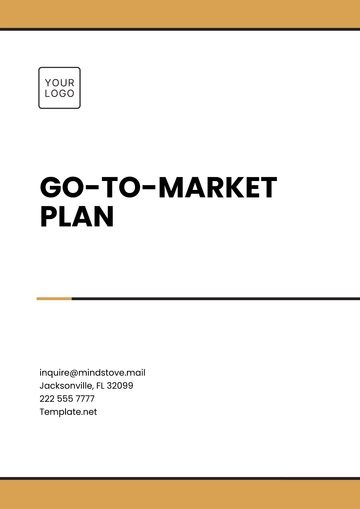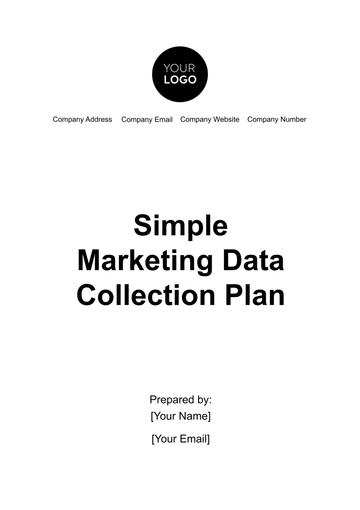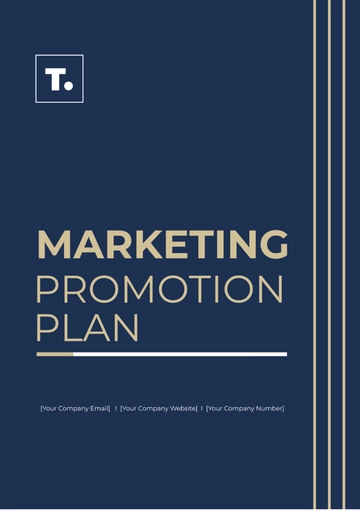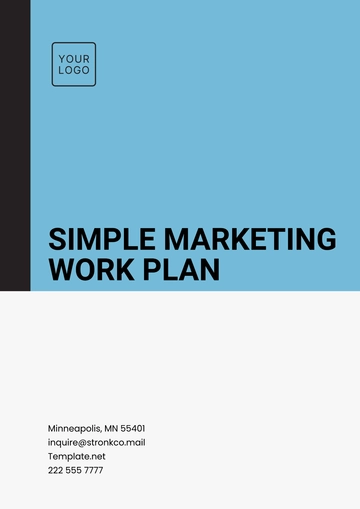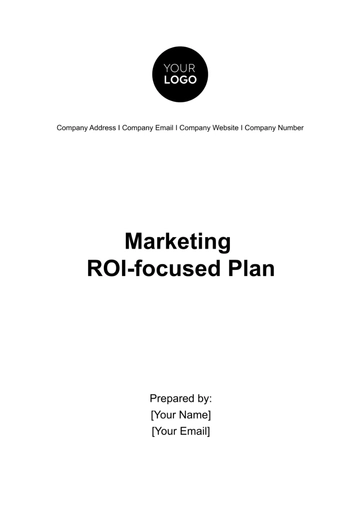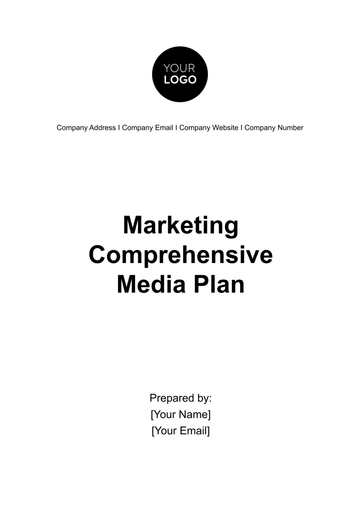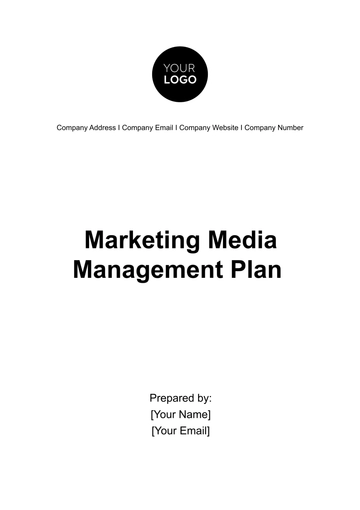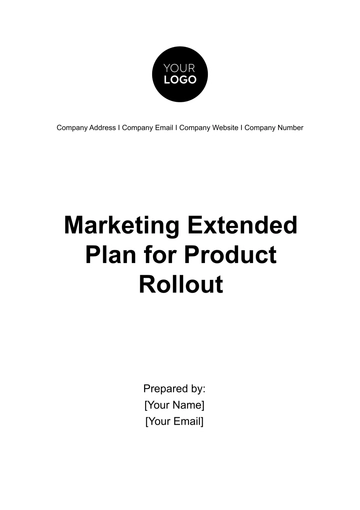Free Marketing User Feedback Management Plan

I. Introduction
Welcome to the Marketing User Feedback Management Plan, a roadmap for harnessing the power of user feedback to steer our marketing strategies toward unparalleled success. In an era defined by dynamic customer preferences and relentless competition, understanding our audience is no longer a choice; it's an imperative.
A. Purpose and Objectives
Our journey begins with a clear purpose and unwavering objectives. The central purpose of this plan is to create a robust framework for collecting, dissecting, and capitalizing on user feedback. Our user feedback is the compass that guides us towards exceptional user experiences, and the data speaks volumes.
Consider this: a recent study by the Customer Satisfaction Institute found that a mere 5% increase in customer satisfaction can lead to an astonishing 75% increase in customer loyalty. And loyalty isn't just a buzzword; it translates into real numbers. Research by Harvard Business Review reveals that loyal customers are, on average, worth up to 10 times as much as their first purchase.
Our objectives are well-defined, serving as beacons of progress:
Improving Customer Satisfaction and Loyalty: We aspire to create marketing strategies that leave our customers not just satisfied but delighted, forging enduring relationships built on trust.
Identifying Areas for Improvement: Our plan includes a meticulous examination of feedback to identify areas where our marketing content and strategies can be enhanced.
Enhancing Campaign Relevance and Effectiveness: In a world where relevance reigns supreme, our marketing campaigns will evolve to deliver precisely what our audience seeks.
B. Scope of the Plan
Our canvas is vast, encompassing the rich tapestry of user feedback obtained through diverse channels. From meticulously crafted surveys to candid interviews, from vigilant social media monitoring to the intricate web of website analytics, we cast a wide net to capture the essence of user sentiments. This plan transcends departmental boundaries; it is a thread that weaves through the very fabric of our marketing endeavor.
C. Target Audience
As we embark on this transformative journey, our audience comprises the diligent members of our marketing team who are entrusted with the task of collecting, dissecting, and acting upon user feedback. Their dedication will propel us forward. But this plan isn't insular; it extends its embrace to include stakeholders beyond our immediate horizon. Our product development teams, our senior management, and every individual invested in our mission to deliver excellence will find value in the insights generated by this plan.
In the following sections, we will delve deeper into the intricacies of our Marketing User Feedback Management Plan, unveiling the strategies, methodologies, and tools that will empower us to transform feedback into fuel for our journey towards marketing excellence.
II. User Feedback Collection
Welcome to the core of our strategy: User Feedback Collection. To shape marketing strategies that resonate with our audience, we need to listen actively, adapt, and refine our approach. Here, we'll explore the methods, timing, and compliance aspects of our user feedback collection plan.
A. Methods of Feedback Collection
Surveys Our journey into the world of user feedback begins with surveys, a structured and direct approach to understanding what our audience thinks. We'll deploy targeted surveys through multiple channels:
These surveys will probe the effectiveness of our marketing content, campaigns, and overall user experiences. |
User Interviews Delving deeper into the intricacies of user preferences, pain points, and suggestions requires a more personal touch. One-on-one or group interviews with select users will offer in-depth insights. These interviews will be conducted strategically:
We will prioritize interviews during post-campaign or product launch periods, ensuring that the feedback aligns with our specific objectives. |
Social Media Monitoring Our brand presence extends far beyond our website and email campaigns, into the realm of social media. To keep a vigilant eye on what our audience is saying, we'll employ social media listening tools. These tools will help us:
|
Website Analytics Our digital footprint is a treasure trove of data waiting to be explored. By leveraging web analytics tools like Google Analytics, we'll track user behavior with precision:
|
B. Timing and Frequency
Surveys: To maintain a steady pulse on user sentiment, we'll conduct quarterly user surveys. This frequency ensures that we capture ongoing feedback and adapt swiftly to changing preferences.
User Interviews: Interviews will be scheduled as needed, with a particular focus on post-campaign or product launch periods. This timing aligns with our goal of assessing the impact of specific marketing efforts.
Social Media Monitoring: Monitoring social media channels will be an ongoing process. We'll track conversations in real time and conduct periodic sentiment analysis to stay attuned to our audience's evolving thoughts.
Website Analytics: Our web analytics will be assessed monthly, allowing us to spot trends and emerging patterns promptly. Monthly reports will be compiled for a comprehensive review by the team.
C. Data Privacy and Compliance
We value the trust our users place in us, and safeguarding their data is paramount. As we collect and handle user data, we are committed to adhering to relevant data privacy regulations such as GDPR or CCPA. Robust security measures will be implemented to ensure the utmost protection of sensitive user information.
In the pages that follow, we'll delve deeper into the mechanisms we have put in place to translate this invaluable user feedback into actionable insights, refining our marketing strategies, and driving excellence in every campaign we undertake.
III. Feedback Analysis and Processing
In the realm of user feedback, gathering data is just the beginning. The true value lies in our ability to sift through this data, extracting insights that will shape our marketing strategies. Here, we outline our approach to feedback analysis and processing.
A. Data Analysis Tools and Techniques
Our journey into the realm of feedback analysis is fortified with an array of data analysis tools and techniques. These instruments allow us to unlock the latent wisdom contained within the data, including:
Sentiment Analysis: By assessing user sentiment, we gain an understanding of the emotional context behind feedback. This analysis helps us gauge overall user satisfaction and pinpoint areas of concern.
Text Mining: Our feedback data harbors a wealth of unstructured text. Text mining techniques enable us to extract valuable information from this uncharted territory, unveiling hidden insights.
Data Visualization: Complex data becomes digestible through data visualization. Visual representations, such as charts and graphs, allow us to spot trends and patterns with ease.
B. Categorization and Prioritization
Navigating through the sea of feedback necessitates order. We categorize user feedback into relevant themes, which might encompass content quality, user interface, or campaign performance. This categorization serves a dual purpose:
Clarity: It provides a structured framework for organizing feedback. |
Prioritization: Feedback is prioritized based on its potential impact and urgency, ensuring that critical issues take precedence. |
C. Identifying Trends and Patterns
Within the vast tapestry of feedback data, patterns emerge like constellations in the night sky. Our analysts diligently sift through the data, identifying recurring trends and patterns. These trends illuminate common issues or opportunities for improvement that might otherwise remain hidden.
D. Feedback Handling Workflow
An organized approach is key to effective feedback handling. We establish a structured workflow that includes:
Roles and Responsibilities: Clearly defined roles ensure that every team member understands their contribution to the feedback analysis process. |
Escalation Procedures: In the event that feedback requires further review or resolution, well-defined escalation procedures guide the way. |
Timelines for Resolution: Timelines are established to ensure that feedback is addressed promptly and efficiently. |
E. Escalation Process for Critical Issues
This process involves relevant stakeholders and senior management, ensuring that urgent matters are swiftly addressed. We recognize the importance of agility in our response to issues that could impact our brand or user experience significantly.
IV. Feedback Utilization
User feedback is a valuable resource that, when harnessed effectively, can drive improvements across various facets of our marketing operations. In this section, we outline how we leverage feedback to make informed decisions and enhance our marketing endeavors.
A. Actionable Insights
This involves a systematic analysis of feedback data to extract relevant and impactful insights. We'll categorize feedback themes, identify recurring issues, and prioritize them based on their potential to influence our marketing goals. By focusing on actionable insights, we can ensure that our feedback utilization efforts result in tangible improvements.
B. Improvements and Enhancements
Upon identifying areas for improvement, we'll initiate a process to implement the necessary changes promptly. This might involve refining website elements, revising content, optimizing user journeys, or adjusting advertising strategies. Each improvement will be driven by specific feedback, ensuring that user concerns are directly addressed. Continuous enhancement based on feedback is integral to our dedication to user satisfaction.
C. Content Creation and Strategy Adjustment
To align with user preferences and expectations, we'll closely examine feedback related to content quality, relevance, and engagement. This data will guide us in refining our content creation processes, ensuring that we deliver valuable and engaging materials. Additionally, we'll use feedback to adjust our marketing strategies, optimizing channels, messaging, and targeting based on user insights. By integrating feedback into our content and strategy development, we enhance our ability to resonate with our audience.
D. Product or Service Development
Feedback related to product usability, features, and performance will inform our product development roadmap. By bridging the gap between marketing and product/service development, we ensure that user feedback leads to meaningful product enhancements that align with user needs.
E. User Communication
We'll establish a clear communication channel to inform users about updates and improvements resulting from their feedback. This not only acknowledges their contributions but also fosters trust and loyalty. User communication serves as a tangible manifestation of our responsiveness and dedication to user satisfaction.
In summary, our approach to feedback utilization is rooted in action, improvement, and alignment with user needs. By translating feedback into actionable insights, implementing enhancements, refining content and strategies, collaborating with product development, and maintaining open communication, we ensure that user feedback remains at the heart of our marketing efforts.
V. Continuous Improvement
Continuous improvement is the cornerstone of our approach to managing user feedback. It involves an ongoing commitment to refining our feedback processes, enhancing our understanding of user needs, and ensuring that our marketing strategies remain responsive to evolving requirements. In this section, we delve into the key aspects of our continuous improvement efforts.
A. Performance Metrics and KPIs
The journey towards continuous improvement begins with a clear definition and regular review of key performance indicators (KPIs) that gauge the effectiveness of our feedback management process. These KPIs act as compass points, guiding our efforts and allowing us to measure progress objectively. Establishing KPIs such as feedback response rates, resolution times, and user satisfaction scores helps us benchmark our performance and identify areas that require attention. By regularly assessing these metrics, we gain invaluable insights into the efficiency and impact of our feedback management initiatives.
B. Regular Review and Reporting
To ensure that our feedback management process remains agile and responsive, we commit to conducting monthly reviews of feedback data and performance metrics. These reviews provide a structured framework for evaluating our progress, identifying trends, and pinpointing areas for improvement. The insights gleaned from these reviews are instrumental in steering our decision-making and shaping our future actions. Furthermore, we recognize the importance of disseminating these findings to relevant stakeholders, ensuring transparency and alignment with organizational goals. Regular reporting fosters accountability and allows us to collectively work towards enhancing our feedback management strategies.
C. Feedback Loop Closure
Closing the feedback loop is a pivotal step in demonstrating our dedication to user-centricity. It involves proactive communication with users who have provided feedback. Upon implementing changes or enhancements based on user input, we'll reach out to those users, informing them of the actions taken as a result of their feedback. This not only acknowledges their contributions but also invites them to be a part of our continuous improvement journey. By seeking further input and encouraging ongoing dialogue, we nurture a sense of partnership with our users, reinforcing our commitment to meeting their needs.
D. Training and Skill Development for the Team
To empower our team members in the realm of feedback collection, analysis, and utilization, we'll prioritize training and skill development initiatives. This encompasses workshops, seminars, and resources that equip our team with the knowledge and tools needed to excel in feedback management. Through continuous learning, our team members will develop the expertise to extract meaningful insights from user feedback, drive strategic improvements, and champion the user-centric approach across our marketing operations.
In conclusion, our commitment to continuous improvement underscores our dedication to delivering exceptional user experiences and refining our marketing strategies. By establishing performance metrics, conducting regular reviews, closing the feedback loop, and investing in team training, we aim to continually elevate our feedback management process and maintain a user-centric approach at the core of our marketing endeavors.
Marketing Templates @ Template.net
- 100% Customizable, free editor
- Access 1 Million+ Templates, photo’s & graphics
- Download or share as a template
- Click and replace photos, graphics, text, backgrounds
- Resize, crop, AI write & more
- Access advanced editor
We are Introducing you to the Marketing User Feedback Management Plan Template from Template.net! This editable and customizable tool streamlines the process of collecting and analyzing user feedback. With our Ai Editor Tool, tailor the plan effortlessly to suit your brand's needs. Enhance user experience and drive business growth effectively. Optimize your feedback management strategy today!
You may also like
- Finance Plan
- Construction Plan
- Sales Plan
- Development Plan
- Career Plan
- Budget Plan
- HR Plan
- Education Plan
- Transition Plan
- Work Plan
- Training Plan
- Communication Plan
- Operation Plan
- Health And Safety Plan
- Strategy Plan
- Professional Development Plan
- Advertising Plan
- Risk Management Plan
- Restaurant Plan
- School Plan
- Nursing Home Patient Care Plan
- Nursing Care Plan
- Plan Event
- Startup Plan
- Social Media Plan
- Staffing Plan
- Annual Plan
- Content Plan
- Payment Plan
- Implementation Plan
- Hotel Plan
- Workout Plan
- Accounting Plan
- Campaign Plan
- Essay Plan
- 30 60 90 Day Plan
- Research Plan
- Recruitment Plan
- 90 Day Plan
- Quarterly Plan
- Emergency Plan
- 5 Year Plan
- Gym Plan
- Personal Plan
- IT and Software Plan
- Treatment Plan
- Real Estate Plan
- Law Firm Plan
- Healthcare Plan
- Improvement Plan
- Media Plan
- 5 Year Business Plan
- Learning Plan
- Marketing Campaign Plan
- Travel Agency Plan
- Cleaning Services Plan
- Interior Design Plan
- Performance Plan
- PR Plan
- Birth Plan
- Life Plan
- SEO Plan
- Disaster Recovery Plan
- Continuity Plan
- Launch Plan
- Legal Plan
- Behavior Plan
- Performance Improvement Plan
- Salon Plan
- Security Plan
- Security Management Plan
- Employee Development Plan
- Quality Plan
- Service Improvement Plan
- Growth Plan
- Incident Response Plan
- Basketball Plan
- Emergency Action Plan
- Product Launch Plan
- Spa Plan
- Employee Training Plan
- Data Analysis Plan
- Employee Action Plan
- Territory Plan
- Audit Plan
- Classroom Plan
- Activity Plan
- Parenting Plan
- Care Plan
- Project Execution Plan
- Exercise Plan
- Internship Plan
- Software Development Plan
- Continuous Improvement Plan
- Leave Plan
- 90 Day Sales Plan
- Advertising Agency Plan
- Employee Transition Plan
- Smart Action Plan
- Workplace Safety Plan
- Behavior Change Plan
- Contingency Plan
- Continuity of Operations Plan
- Health Plan
- Quality Control Plan
- Self Plan
- Sports Development Plan
- Change Management Plan
- Ecommerce Plan
- Personal Financial Plan
- Process Improvement Plan
- 30-60-90 Day Sales Plan
- Crisis Management Plan
- Engagement Plan
- Execution Plan
- Pandemic Plan
- Quality Assurance Plan
- Service Continuity Plan
- Agile Project Plan
- Fundraising Plan
- Job Transition Plan
- Asset Maintenance Plan
- Maintenance Plan
- Software Test Plan
- Staff Training and Development Plan
- 3 Year Plan
- Brand Activation Plan
- Release Plan
- Resource Plan
- Risk Mitigation Plan
- Teacher Plan
- 30 60 90 Day Plan for New Manager
- Food Safety Plan
- Food Truck Plan
- Hiring Plan
- Quality Management Plan
- Wellness Plan
- Behavior Intervention Plan
- Bonus Plan
- Investment Plan
- Maternity Leave Plan
- Pandemic Response Plan
- Succession Planning
- Coaching Plan
- Configuration Management Plan
- Remote Work Plan
- Self Care Plan
- Teaching Plan
- 100-Day Plan
- HACCP Plan
- Student Plan
- Sustainability Plan
- 30 60 90 Day Plan for Interview
- Access Plan
- Site Specific Safety Plan






